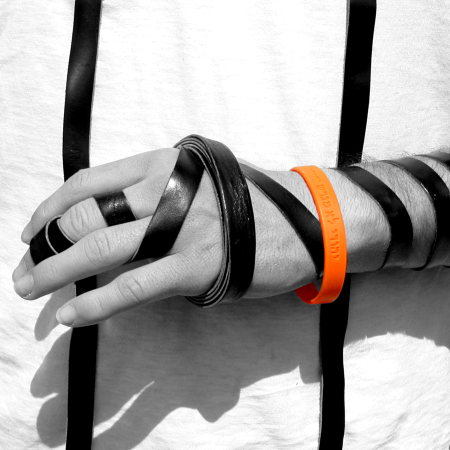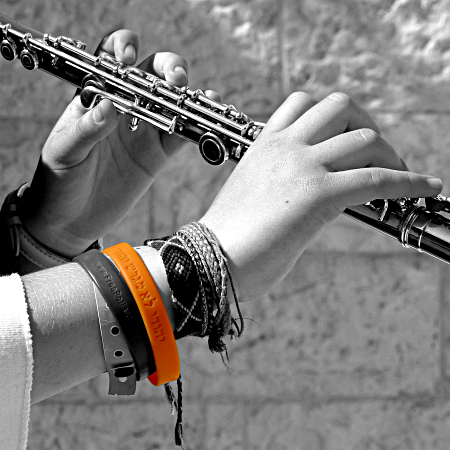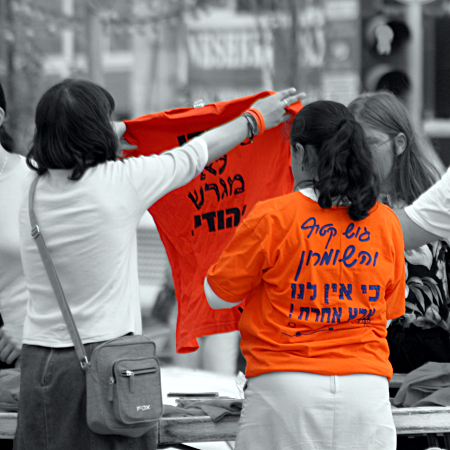Actualities in Black & Orange
In December 2003, the Israeli
Prime Minister announced his decision to “withdraw” from
the Gaza Strip and from four Shomron towns by the end of 2005. As
these regions served as home to some ten thousand Jews — Israelis — in
 twenty-five towns and villages, this move also meant the destruction
of these communities and the removal of all the Jewish residents.
Existing organisations and new grass roots movements arose to protest
the government decision.
twenty-five towns and villages, this move also meant the destruction
of these communities and the removal of all the Jewish residents.
Existing organisations and new grass roots movements arose to protest
the government decision.
The colour Orange became the symbol of the anti-“disengagement” campaign. Orange started to appear on the Israeli scene in the middle of 2004. It increased in intensity, becoming ubiquitous in many parts of the country. People, cars, flag poles, even animals, displayed orange in some form: bracelets, clothing, flags, posters, and ribbons tied to just about everything. Orange backgrounds carried messages on t-shirts, bumper stickers, car flags and billboards. Though the messages varied over time, the predominant themes were solidarity with Gush Katif and the northern Shomron and the slogan, “Jews do not expel Jews”.
Orange also became a matter of identity. It showed identification with the cause, and allowed like-minded people to recognise each other.
My aim is to document the Orange phenomenon through the eye of an artist. My chosen medium is black and white photography, with orange the only colour visible. My work is not journalistic, nor do I claim to have documented the entire campaign. My camera is with me wherever I go and I photograph what I see.

I photographed in many locations, both inside and outside of Gush Katif, recording the world I saw. I portray normal people going about their everyday lives: playing music, dancing, praying and even taking part in legal protests. But these people became part of a campaign against what they saw as an injustice being carried out by the government that many of them had helped to elect. Although demonised by the media, they displayed Orange as a symbol of pride and hope.
The first public display of photographs in the Black & Orange collection was held on 28th June, 2005, at the former Gush Katif Hotel, then renamed Maoz Yam. A group of people had moved into the hotel, which was in a very poor state of repair, and with the permission of the owners, were renovating the complex. The Gush Katif veterans were a little suspicious of the new residents. In order to diffuse tensions, a cultural evening was organised to allow both groups to meet each other. My exhibition of fifteen photographs was the draw card. The evening was a tremendous success, but the government raided the hotel two later. I wrote an article on my feelings at this time. You can view an illustrated version of the article on my site.
At about this time, in addition to the Black & Orange photographs, I produced a pictorial bencher, Birchon Katif. It features photographs of the life and vibrancy of the Gush. Many people have acquired the bencher, both for gifts at weddings, bar-mitzvas, etc, or for personal use. It has had a very profound effect on many of the people who use it. A percentage of the income from the birchon has been donated to various projects relating to Gush Katif.
I, like many others, had a very
difficult summer. It was hard for me to work effectively. My mind was elsewhere —
in the Gush. So I kept
returning there; there wasn't a lot I thought I could really
 do, but I knew that I had to be there. Working on the photographs in
this collection was very therapeutic; it helped me maintain my
sanity. I always believed that the large showing of people in the
Gush and the other villages under threat, mass refusal by the army to carry out
orders, and the sheer weight of public opinion, would force the
government to drop its plans. It was only in the very last two or three days that
I realised that this was not going to happen — the Gush was going to
be destroyed. The people of Israel were not yet prepared to fight the battle.
do, but I knew that I had to be there. Working on the photographs in
this collection was very therapeutic; it helped me maintain my
sanity. I always believed that the large showing of people in the
Gush and the other villages under threat, mass refusal by the army to carry out
orders, and the sheer weight of public opinion, would force the
government to drop its plans. It was only in the very last two or three days that
I realised that this was not going to happen — the Gush was going to
be destroyed. The people of Israel were not yet prepared to fight the battle.
About Myself
I was born and grew up in Australia. My earliest photographs were taken with an old Kodak box camera which my uncle gave me when I was eight years old.
Only years later did
I start to do any serious photographic work. With some friends in Sydney, I set up
a darkroom from which I produced diverse photographic work in both
 black & white and colour. I strongly believe that the camera is
only a part of producing a photograph; the darkroom constitutes a
major aspect of the creative process.
black & white and colour. I strongly believe that the camera is
only a part of producing a photograph; the darkroom constitutes a
major aspect of the creative process.
On moving to Israel in 1983, I no longer had access to a darkroom and my photographic output dropped. Now with the latest advances in photography, I have made the switch to digital cameras and to the “digital darkroom”. The new technology has turned the clock back over twenty years, allowing me to again produce fine art photography and to further my creative development. With the obvious exception of the Black & Orange photographs, I try to limit computer manipulations to those which I could have done in a traditional darkroom. Together with my wife Jillian and our six children, we have lived in Efrat for over twenty years.
My work can be viewed on the internet at www.MenachemKuchar.com, from where original signed prints and the book may be purchased.
Conclusion
The actual “dismantlement” of these centres of Jewish population began on 10th Av, 15th August. Although the last Jew has been exiled, the last Israeli soldier has been relocated from Gaza and once vibrant communities lie in ruin, Orange continues. There are new messages and new campaigns, but Orange is still there, a symbol of the past and a beacon to the future.
Menachem Kuchar
Efrat
www.MenachemKuchar.com